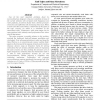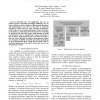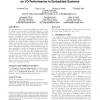599 search results - page 43 / 120 » Energy and Performance Models for Synchronous and Asynchrono... |
ISCA
2005
IEEE
14 years 1 months ago
2005
IEEE
One of the most important problems faced by microarchitecture designers is the poor scalability of some of the current solutions with increased clock frequencies and wider pipelin...
IPPS
2010
IEEE
13 years 5 months ago
2010
IEEE
Predicting how well applications may run on modern systems is becoming increasingly challenging. It is no longer sufficient to look at number of floating point operations and commu...
SAC
2009
ACM
14 years 2 months ago
2009
ACM
File systems make use of part of DRAM as the buffer cache to enhance its performance in traditional systems. In this paper, we consider the use of Non-Volatile RAM (NVRAM) as a w...
TC
2008
13 years 7 months ago
2008
Synchronous systems offer clean semantics and an easy verification path at the expense of often inefficient implementations. Capturing design specifications as synchronous models a...
ESEC
1999
Springer
14 years 4 days ago
1999
Springer
CIP is a model-based software development method for embedded systems. The problem of constructing an embedded system is decomposed into a functional and a connection problem. The ...



